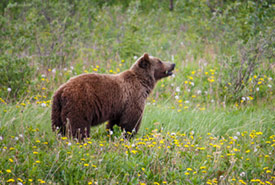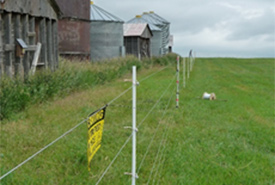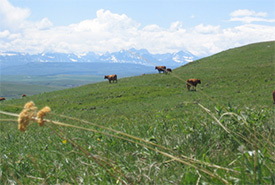Andrea Morehouse-Waterton Biosphere Reserve, Director and Science and Stewardship Coordinator

Grizzly bear (Photo from Pixabay)
Carnivores and Communities Program evaluation
What is the problem you are looking to solve or the question you are looking to answer?
Southwestern Alberta is a provincial hot spot of carnivore-agricultural conflicts. The Waterton Biosphere Reserve’s (WBR) Carnivores and Communities Program (CACP) focusses on decreasing conflicts between large carnivores and people in an agricultural landscape by supporting the community through collaborative projects, capacity building and educational outreach. The program began in 2009 and operates in the municipalities of Ranchland, Pincher Creek, Willow Creek and Cardston. We were interested in evaluating how well the CACP is working and learning what areas we could improve.
Can you give us a general description of the project?
We evaluated the CACP’s bear safety workshops, *deadstock removal program and attractant management projects by collecting survey data on participants’ perspectives of the CACP’s effectiveness relative to reducing economic costs and human safety risks and by completing an analysis of carnivore conflict data. In 2018, we used an online survey to evaluate the effectiveness of the CACP directly from the program participants’ perspectives and experiences. The survey was organized into the following sections: demographics; general awareness and motivation to participate; safety risks and sense of security associated with large carnivores; assessment of attractant management and deadstock removal programming’ and communications and future direction.
We used southwestern Alberta occurrence records (i.e. Fish and Wildlife complaint data) from 1999 through 2016 to evaluate trends over time in large carnivore (e.g., grizzly bear, black bear, cougar, wolf) incident type.
Incident = situation where the large carnivore caused property damage, obtained anthropogenic food, killed or attempted to kill livestock or pets, or was involved in a vehicle collision.
We focussed on incidents related to the deadstock removal program and attractant management projects (e.g., electric fence, grain bin upgrades). We further focussed on grizzly bear incidents because all CACP attractant management projects have been designed predominantly to mitigate bear-agricultural conflicts.
What will you learn from your project?

Electric fencing (Photo by Andrea Morehouse)
Through our community survey and review of carnivore conflict data, we have increased our understanding of the effectiveness of the CACP. We have learned that our deadstock removal, attractant management and bear safety programs are having a positive impact. For example, 75.5% of survey respondents said the deadstock removal program has helped reduce carnivore conflicts. Similarly, deadstock incidents have declined since the start of the CACP in 2009. Further, 67.9% of survey respondents said the attractant management program is effective in reducing conflicts, and the occurrence records show a decrease in grizzly bear attractant incidents post-CACP implementation. Finally, survey respondents had favourable views of the CACP’s bear safety workshops, with 49.5% of survey respondents stating that the bear safety workshops increased their sense of safety. Remarkably, 61.2% of workshop participants said they now carry bear spray as a result of the training provided by the CACP.
What is the biggest achievement of the project to date?
Our project has benefitted the CACP by identifying areas of success as well as areas that require further work. For example, while we have made significant progress in reducing attractants, depredation of livestock by large carnivores remains a significant problem. Further, we have learned that the southwestern Alberta community is well informed about the CACP’s deadstock removal program and bear safety workshops but is less informed about the availability of funding for cost-shared attractant management projects. This information will help us improve the CACP, moving forward. We would not have obtained this information without this project.
Finally, we are also pleased to share that we have recently published our work in the journal Frontiers in Ecology and Evolution. The paper can be found here.
How can this project benefit NCC’s work and other conservation initiatives?
Facilitating long-term coexistence between people and large carnivores is a persistent, global conservation challenge. NCC works to conserve important natural areas and biological diversity. Large carnivores are part of the biological diversity in southwestern Alberta, but limited public lands means there is a large overlap between carnivore home ranges and agricultural land uses. Ensuring the persistence of large carnivores in this region of the province requires finding solutions to human-carnivore conflicts. The CACP works to promote coexistence between people and large carnivores through a variety of conflict mitigation options. Prior to our project, these mitigation options had not been evaluated. Indeed, the literature currently lacks concrete examples of program evaluations for conflict mitigation options. Our results provide information that is useful for other conservation organizations dealing with human-wildlife conflicts.
What is your favourite part of the project you are working on?
Through our community survey, we have heard directly from community members about their perspectives of the CACP. Learning community perspectives on our programming has been invaluable, and this information will help guide further CACP efforts.
What gets you excited about the species/habitat your project is investigating?

Cattle in Waterton (Photo by Jeff Bectell)
In many places in the world, large carnivore populations are declining or no longer occur in their historical range. Southwestern Alberta is unique in that all four native large carnivores (grizzly bear, black bear, wolf and cougar) are all still present. While living with these large carnivores creates a number of challenges, knowing these carnivores are present is exciting. Seeing a grizzly bear or hearing a wolf howl is a unique experience that not everyone gets to have. Finding ways to keep both people and carnivores on the landscape is both challenging and rewarding.
What is the impact you are hoping to achieve in Alberta (or beyond) with the project you are involved with?
We hope to provide information that is useful not only for the continuation of the Carnivores and Communities Program, but also for conservation efforts more broadly. We believe our project will provide information that will be beneficial to other organizations that are working on human-carnivore conflicts. For example, getting the public to carry bear spray can be a challenging task, and the fact that over half of the CACP’s bear safety workshop participants now carry bear spray speaks to its success. We believe the information regarding the development of the program and the social theory context we discuss will provide useful information that would benefit other community-based projects as they attempt to develop or implement similar workshops.
Is there a place where people who are interested in your project can go to learn more?
More information on the Carnivores and Communities Program can be found at here.
More details about our program evaluation can be found in our recently published paper here.
Project fun fact you would like to share?
A few program highlights from 2009 through 2019 include:
-removed ~5,000 livestock carcasses from the landscape;
-completed 77 attractant management projects; and
-hosted nine bear safety workshops.





